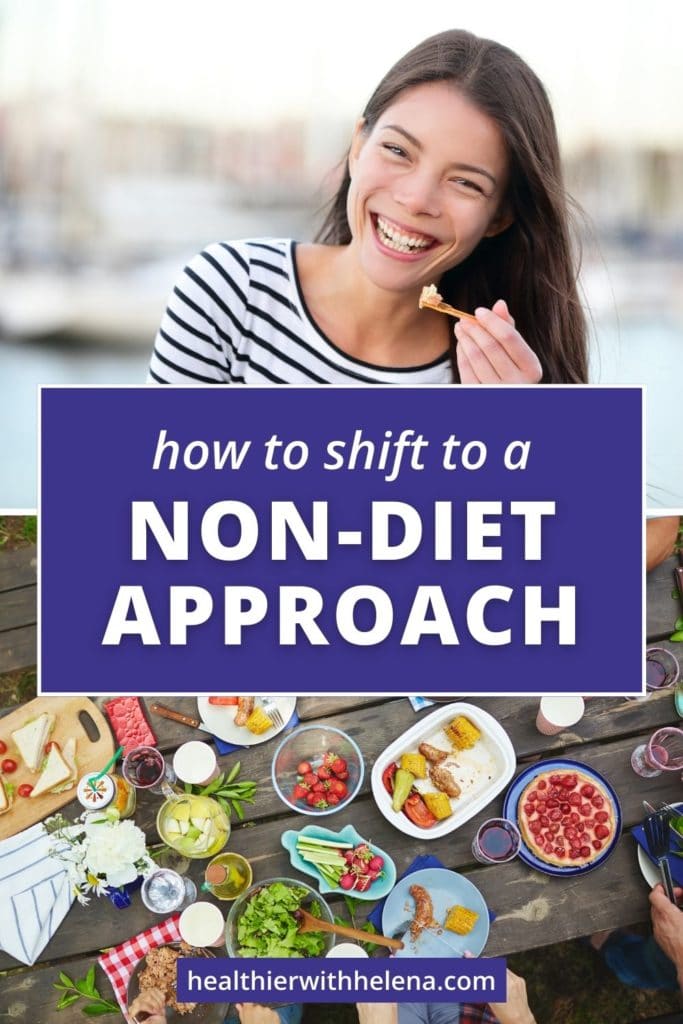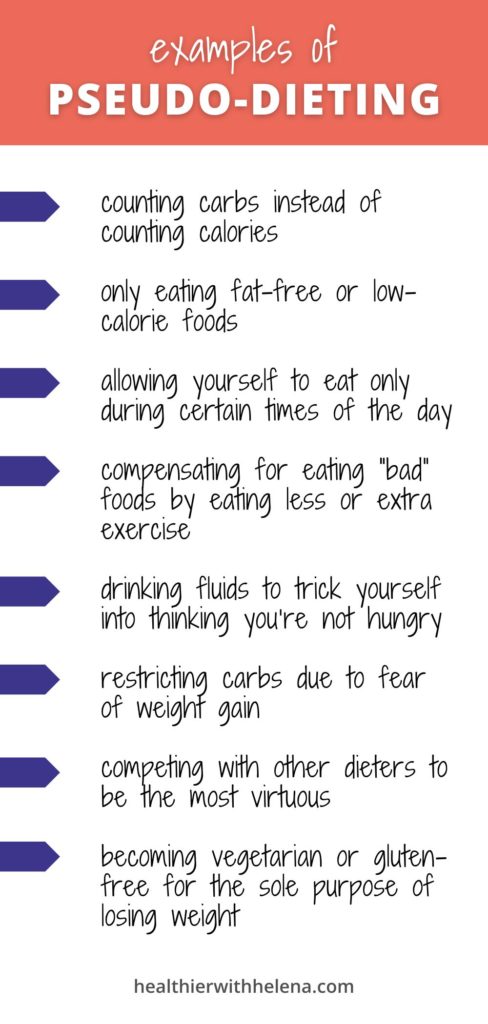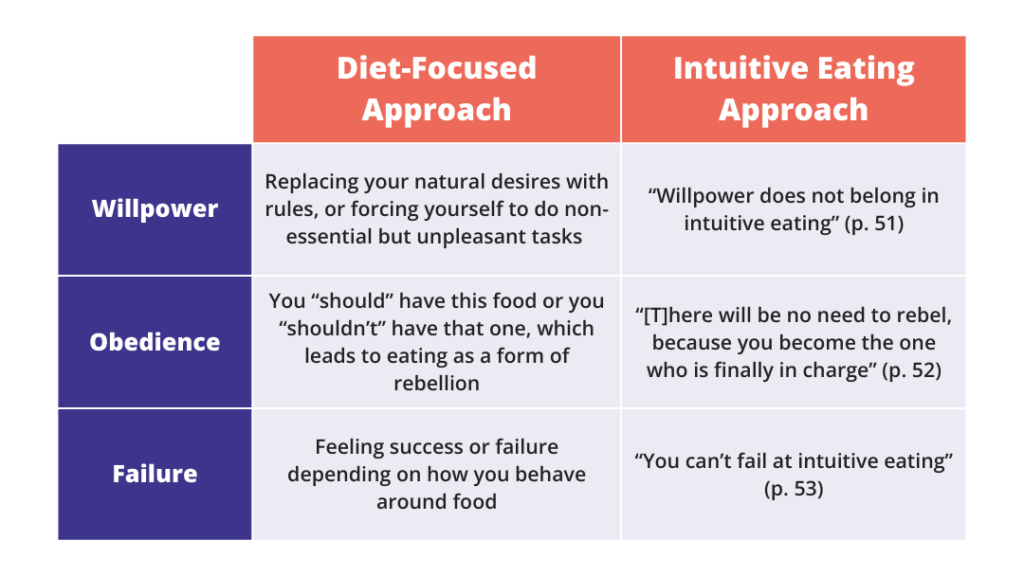Are you sick of dieting? Have you realized that it doesn’t lead to lasting weight loss? Do you want to be healthier, but without dieting in your life, you just don’t know how to eat? You’ve come to the right place! In today’s post, I’m going to talk about rejecting the diet mentality. This non-diet approach can change your health, and your relationship with food, for the better.
(Pin this post to read later)

What do you mean by “reject the diet mentality” and “non-diet approach”?
Before discussing the steps to reject the diet mentality, I want to talk about where that phrase comes from. “Reject the diet mentality” is the term used in the book “Intuitive Eating” to describe the first principle of becoming an intuitive eater. (Check out my earlier post where I give an overview of the intuitive eating principles if you want to learn more about intuitive eating in general.) Also note that I will be using the phrases “reject the diet mentality” and “non-diet approach” interchangeably throughout this post.
The case for a non-diet approach
You may be wondering: is it truly possible to stop dieting? After all, how you can control your eating or lose weight without being on a diet?
The truth of the matter is that diets don’t work (more on this later). In fact, dieters often end up heavier than before they started dieting:
“[D]ieting is a strong predictor of future weight gain . . . When dieters regain their lost weight, they gain fat faster than they gain muscle, which leads them to replace muscle with fat or to recover their strength at the cost of putting on extra weight . . . These results suggest that dieting may be counterproductive for many people, as it leads to weight gain, on average, rather than loss. (1)
[A] body of research shows that the act of dieting increases your risk of gaining even more weight. This holds true for kids, teens, and adults. (2)
Given the choice between dieting and deprivation, with the likely result of weight gain, versus intuitive eating and fulfilling your body’s needs, resulting in weight maintenance or loss, I would pick the latter!
Why it is scary to stop dieting
If you have dieted many times in the past, it can be scary to think of life without a diet. How will you know what to eat, when, and how much? If you’re not dieting, you may fear:
- You will not be able to stop eating, because you overeat when you are not following a diet
- You won’t know what to eat, because dieting has informed your food choices
- You will lose control around food, because dieting has provided the guide rails to keep your eating in check
These are all valid, normal concerns when transitioning to a non-diet approach! But luckily, they are also unfounded. Here’s why:
- When you’re dieting, you’re essentially putting yourself in starvation mode, and overeating is the normal physiological response to that. Once your body realizes that you’re no longer starving it, your drive to eat will normalize.
- Your body is wise and knows what to eat. You just need to learn how to get reacquainted with its signals again.
- You are the expert of your own body. When you learn to trust and listen to yourself, it is empowering.
So although you may feel apprehension about rejecting the diet mentality, rest assured that this approach will pay off in the long-term.
Can’t I diet and practice intuitive eating at the same time?
Now that you understand why intuitive eating puts you back in charge of your relationship with food, you may be wondering why you can’t just do both – diet and practice intuitive eating at the same time.
Here’s why: dieting and intuitive eating are mutually exclusive. Intuitive eating requires you to follow your body’s internal signals. Dieting, by definition, demands you follow external cues about what, when, and how much to eat. You can’t follow both internal and external cues at the same time. So you must decide to let go of dieting in order to truly practice intuitive eating.
In addition to not overtly dieting, you cannot pseudo-diet and still engage in intuitive eating. The reason being that if some part of you still believes that dieting will work for you, it can sabotage your efforts at intuitive eating. You need to fully give up dieting and all its trappings in order to move forward with an intuitive eating practice.
What is pseudo-dieting?
Pseudo-dieting is a form of subconscious dieting. It’s when you’re technically not on a diet, but still have dieting thoughts which can then manifest as dieting behaviors. It can be difficult to spot this in yourself, so don’t beat yourself up if you realize you’ve been doing it! The first step in overcoming pseudo-dieting is awareness.
Here is a list of some examples of pseudo-dieting:

How to reject the diet mentality – steps to a non-diet approach
Now that we’ve discussed reasons why a non-diet approach is beneficial, let’s talk about how to reject the diet mentality. Here are four steps described in “Intuitive Eating” to accomplish this:
- Step 1 – realize and acknowledge the detrimental effects of dieting
- Step 2 – recognize how the diet mentality can present itself in your thoughts and actions
- Step 3 – stop using tools that enable dieting
- Step 4 – have self-compassion
Step 1 – realize and acknowledge the detrimental effects of dieting
Firstly, switching to a non-diet approach requires a shift in the way that you think. You must stop believing the “cultural myth” that diets work. You must recognize the damaging effects of dieting and accept that dieting will not solve your problems.
All that being said, you may be wondering: how do diets harm you?
In addition to the weight gain mentioned above, diets also harm you biologically, psychologically, and emotionally. Chronic dieting decreases your metabolism, provokes abdominal fat storage, and induces cravings and binges. It is correlated with with feelings of failure, and it is linked to eating disorders. It erodes your confidence and your self-trust. And these are just a few examples of how dieting can hurt you!
In contrast, intuitive eating helps you regain a sense of control around food. If your weight has been impacted by repeated diets, or by over or undereating, it can also help your weight to normalize. Once you understand that dieting is not just ineffective, but also harmful, then it is easier to let go of the dieting mentality.
Step 2 – recognize how the diet mentality can present itself in your thoughts and actions
Once you have accepted the detrimental effects of dieting, look inside yourself to see how the dieting mentality manifests for you personally. Some common ways it can show up are:

Step 3 – stop using tools that enable dieting
The third step to rejecting the diet mentality is to get rid of “dieter’s tools.” These are basically external forces used to regulate your eating. Some of the dieter’s tools include:
- A regimented food plan or eating schedule
- Food scales
- Bathroom scales
Although I personally love meal planning, I recommend using it as a guideline. Following a rigid eating plan or schedule is not conducive to eating intuitively.
Additionally, it is not necessary to weigh yourself, or your food, in order to be healthy. It is okay to weight yourself every once in a while as long as it does not trigger you. (To give an example – we moved this summer, and I just unpacked my bathroom scale after it being in a box for the last three months. I am a weight-maintainer, and my weight was essentially the same as when that scale went into the box in California.) It is also alright to occasionally weigh or measure your food in order to be reminded of what a portion looks like. But religiously weighing or measuring food is generally not helpful.
I also want to mention that you can refuse to be weighed at a doctor’s office too, if knowing your weight is triggering. Not everyone knows this, and you may sometimes receive pushback from the nurse. But it is completely within your right to say no. You can also be weighed facing away from the scale and ask not to know or discuss your weight during your appointment.
Step 4 – have self-compassion
The final step in rejecting the diet mentality is to have compassion for yourself as you give up dieting. Although dieting doesn’t work as a form of weight loss, it does provide other benefits.
For example, being on a diet offers excitement and hope, both of losing weight and of becoming a new and improved person. Socially speaking, “diet bonding” gives us something to talk about and relate to with other dieters. Dieting can even give us a sense of purpose, fulfilling a spiritual hunger.
Those can be difficult things to let go of, so don’t be too hard on yourself if you are still seduced by the idea of one more diet.
Shifting to a non-diet approach – in summary
Now that you understand the harm that dieting ultimately causes, I hope this post has given you the courage to try a non-diet approach. I encourage you to give it a chance: stop believing another diet will work for you. Start eating using your body’s signals as a guide. See what happens. I suspect you will find it to be a more enjoyable and gracious way of interacting with food.
Want to explore intuitive eating? Reach out using the button below!
References
Note this post was based on chapter 5 of: Tribole, E. and Resch, E. (2012) Intuitive eating. 3rd ed. New York: St. Martin’s Griffin.
- Aamodt, S. (2016) Why diets make us fat: the unintended consequences of our obsession with weight loss. New York, New York: Current, an imprint of Penguin Random House LLC. (p. 40-41)
- Tribole, E. and Resch, E. (2012) Intuitive eating. 3rd ed. New York: St. Martin’s Griffin. (p. 43)
- Featured image credit: Photo by Alex Haney on Unsplash







0 Comments